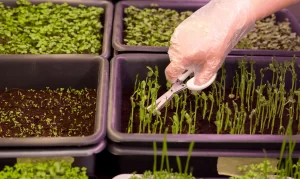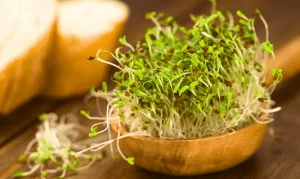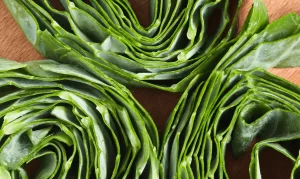Most Popular Microgreens for Chefs: Chefs are continually changing their menus to make something fresh and exciting for their customers’ palates.
They include microgreens for various reasons, including taste, beauty, and, of course, health benefits. Furthermore, microgreens are delicious in salads, soups, smoothies, drinks, sandwiches, and even garnishes. It’s because they have distinct flavors that add flavor to every dish, and the colors are appealing to the eye.
Some chefs enjoy combining four or five microgreens to make a rainbow blend. They then garnish different plates with the mixture. Although numerous microgreens are on the market, the following are the most common microgreens among chefs.
Contents
- Most Popular Microgreens for Chefs
- Alfalfa
- Beet
- Buckwheat
- Clover
- Collard
- Kale
- Kohlrabi
- Pea
- Arugula
- Radish
- Swiss Chard
- Carrots
- Basil
- Popcorn
- Sunflower
- Magenta Spreen
- Red-veined Sorrel
- Other Microgreens that Chefs Use
- Frequently Answered Questions on Microgreens
- Can Microgreens Be Grown Outside?
- Will Microgreens Regrow?
- How Long Will Microgreens Last?
- Conclusion: Most Popular Microgreens for Chefs
Most Popular Microgreens for Chefs
Alfalfa
- Alfalfa is grown hydroponically, where it germinates in 1-2 days and is harvested in 8 to 12 days.
- The leaves are big and deep green, with a slight crunch and flavor.
- They are best used to add crunch to salads and sandwiches.
Beet
- Beet microgreens grow best in soil.
- They germinate in 6-8 days and are ready to harvest in 10-12 days.
- The microgreens are prized for their bright green leaves and dark red roots, which are ideal for adding color to any dish.
- Chefs love the Detroit Dark Red beet microgreens for their earthy, slightly bitter flavor. They use it to top off beet hummus, a visual and sensory treat.
Buckwheat
- Buckwheat microgreens are grown in soil to germinate easily in 1-2 days.
- It will be able to harvest in 6-12 days.
- Although the leaves are yellow when young, sunlight causes them to turn green gradually.
- Chefs love buckwheat microgreens for their tangy taste and use them in gluten-free dishes.
Clover
- Hydroponically cultivated clover microgreens are preferred.
- It germinates in 1-2 days and is ready for harvesting in 8 to 12 days.
- Clover microgreens have green leaves that have a light, new taste.
- Younger clover microgreens have a sweeter flavor, are excellent for garnishing, and add crunch to any salad.
Collard
- Collard microgreens are grown hydroponically, where they germinate in 1-2 days and mature in 10-12 days.
- They are dark green in color and taste similar to adult collards but with a stronger flavor.
- Collard is best used as a garnish, such as for decorating spaghetti and salads.
Kale
- This kind of microgreen is hydroponically cultivated.
- They germinate in 2-3 days and are ready for harvest in 8-12 days.
- These microgreens are green and taste similar to red leaf lettuce and regular romaine.
- As a result, they make an excellent foundation for microgreen salads and tasty addition to many smoothies.
Kohlrabi
- Kohlrabi grows best hydroponically, where it germinates in 2-5 days and matures in 8 to 12 days.
- They have green leaves and white roots, and their taste is mild and cabbage-like.
- Chefs mostly use them in salads, sandwiches, and slaw.
Pea
- Pea microgreens are grown in soil, where they germinate in 2-3 days and mature in 8 to 12 days.
- These microgreens have a crisp texture and a fresh, slightly sweet taste.
- Chefs love pea microgreens because of their pleasantly rounded big leaves. They make an excellent omelet garnish and tasty addition to a strawberry salad.
Arugula
- When grown in soil, arugula microgreens germinate in 2-3 days and are ready to harvest in 5 to 7 days.
- They have a sharp, peppery flavor that chefs use to accompany various salads and sandwiches.
- Micro arugula complements roasted beet carpaccio and goat cheese.
Radish
- Hydroponically cultivated radish microgreens are preferable.
- They germinate in 1-2 days and can be harvested in 5-12 days.
- Because of its crispness and flavor, radish is a chef’s favorite microgreen.
- They have an excellent radish flavor and a slight crunch to them.
- Since they are green and red, they are mostly used for garnishing and improving the appearance of a dish.
- Radish microgreens are also an excellent addition to dishes such as watermelon avocado salad and as a topping for sandwiches such as salmon burgers.
- They also go well with sushi and Asian cuisine and are usually available.
Learn more about Most Profitable Plants To Grow In A Greenhouse
Swiss Chard
- Microgreen Swiss chard grows best in soil.
- They germinate in 2–5 days and are ready to harvest in 8–12 days.
- The microgreens are a darker green color with a spinach taste, and they make an excellent addition to any salad or pizza.
- Chefs love Bright Lights Chard microgreens for their vibrant color and subtle yet versatile taste.
Carrots
- Carrot microgreens have a mildly sweet taste and are often used by chefs to add flavor and flair to dishes.
- These microgreens, however, grow slowly in comparison to other microgreens.
- They germinate in seven days and are ready for harvesting after four weeks or more.
Basil
- Chefs love basil microgreens for their sweet and savory flavor profile.
- It is more expensive, but it is available until the end of the summer.
- It goes well with heirloom tomatoes and makes an excellent cocktail garnish.
Popcorn
- Popcorn shoots add a subtle and sweet flavor to dishes, and they go particularly well with shellfish.
- Because of their small scale, chefs often use microgreens.
Sunflower
- The flavor of micro sunflower shoots is mild, but it has a nutty undertone.
- These microgreens, which are relatively inexpensive, go well with a green salad and artisan cheese.
- Sunflower shoots come in a variety of colors and shapes.
- The Black Oil variety is a big microgreen used to improve the appearance and nutritional value of a plate.
Magenta Spreen
- It takes about 12 to 14 days for Magenta Spreen to germinate and at least four weeks to harvest.
- Though they take a long time to mature, chefs agree that the mild and generic flavor and colors are well worth the wait.
Red-veined Sorrel
- Red-veined sorrel microgreens take a while to sprout, but once they do, they’re a prolific grower.
- Chefs are so taken with the unique lemony flavor of red-veined sorrel microgreens that they have become a trend.
- In addition, chefs also use it to enhance the appearance of a dish.
Other Microgreens that Chefs Use
- Broccoli
- Mustard wasabi
- Onions
- Fennel
- Red amaranth
- Purple cabbage
- Mung bean
- Cilantro
- Celery
Frequently Answered Questions on Microgreens
Can Microgreens Be Grown Outside?
Microgreens are fragile, and like all young seedlings, they benefit from extra protection from the harsh environment outside. Heat, sun, and wind will dry them out, and their tender leaves are a favorite snack of pests. Fortunately, most microgreens thrive indoors since they prefer room temperatures (70°F to 80°F) and partially filtered light from a window. If you have an indoor windowsill, this is the best place to cultivate your microgreens.
You can take a few steps if you want to grow them outside. To begin, make sure it is not too cold when you start, as the seed will struggle to sprout below 65 °F. Second, avoid harsh conditions by setting up in a partially shaded, wind-protected location. Finally, if you see flies, caterpillars, or bugs, give them a thorough rinse before feeding (pesticides are not recommended).
Will Microgreens Regrow?
Many gardeners are used to being able to take a few leaves at a time from their herbs or greens and have the plant regenerate just fine – it’s a perfect way to get the most out of your plants! Although we wish this worked for microgreens, most can only be harvested once.
It is because most microgreens only have one collection of leaves, so once harvested, there is little left to absorb the sunlight needed to grow back. There are, however, a few exceptions to this law. Microgreen shoots, including peas, beans, and lentils, can regrow a couple of times if harvested above the bottom leaf. After the first harvest, the flavor begins to fade, but you can normally get these to regrow once or twice with good flavor and texture.
How Long Will Microgreens Last?
As previously mentioned, it is best not to cut and store your microgreens but rather to harvest them as required while they are still growing. You usually have about a week between your first and last harvest, so if you can use them up during that period, you’ll be eating the freshest and healthiest microgreens possible. However, if you’ve made it to the end and still have any left, they’ll keep for another week or two under the right conditions.
First, put a folded paper towel in the bottom of an airtight jar to store them properly. Then, loosely put the microgreens in the container (the delicate greens are easily crushed) and close the lid. Finally, put it in your refrigerator’s bottom shelf or produce drawer (away from the cool air vent where the temps tend to fluctuate).
Conclusion: Most Popular Microgreens for Chefs
In a nutshell, most microgreens are well-liked by chefs. It is up to the chef to use their culinary skills to complement microgreens with appropriate dishes. According to current trends, some chefs can use microgreens. Others may prefer seasonal microgreens.
Read more about How to Grow Microgreens Commercially?
Others may use them to make a rainbow mix to improve the appearance and nutritional value. Microgreens’ colors, crunch, and flavors are just what chefs need to tickle their customers’ tongues and keep them coming back for more.






